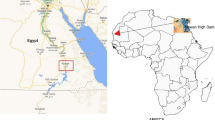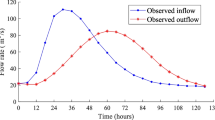Abstract
Advances in computational science have made an explosion of computational models for analyzing and predicting the behavior of complex environmental systems possible, such as river models. Model accuracy is highly influenced by many sources of uncertainties, and one of these sources is parameter uncertainty. In this research, we present a search and optimization methodology to achieve a higher prediction quality of a computational system for calculating the translation of waves in rivers. Our proposal aims to achieve this goal using the least amount of computational resources. We address this issue by performing a two-phase optimization via simulation methodology. The first phase consists in a global exploration step over the entire search space. This phase identifies promising regions for optimization based on a neighborhood structure of the problem, using a Monte Carlo heuristic plus the K-means method. The second phase is a fine-grained approach that consists in seeking the best solution, either the optimum or a sub-optimum by performing a “reduced exhaustive search” in such promising regions. We achieve a speed-up of 20× when searching the best parameter settings in comparison with an exhaustive search in the whole space of candidates’ parameter settings. This acceleration is measured in terms of the number of simulations run required to find a solution. When using our methodology and parallel computing, we reduced from 11 to 0.5 days the complete time. We achieved a 22× gain, fulfilling the objective of reducing the use of computing resources.







Similar content being viewed by others
Data availability
My manuscript has not associated data.
Notes
In this site we can find the data needed for the validation methodology, i.e., https://alerta.ina.gob.ar/pub/mapa.
INA. Hydraulic Laboratory. Study of hydraulic problems, through theoretical and experimental analysis, and simulation in physical and mathematical models. Available online at https://www.ina.gov.ar/lha/index.php.
References
Knutti R (2018) chap. Climate modelling. In: Lloyd EA, Winsberg E (eds) Climate modelling. Palgrave Macmillan, Cham, pp 325–359
Phillips W, Fahy R, Beller DK (2016) Progress in IS. In: Hurley MJ (ed) SFPE handbook of fire protection engineering. Springer, New York, pp 3117–3136
Balica S, Popescu I, Beevers L, Wright N (2013) Parametric and physically based modelling techniques for flood risk and vulnerability assessment: a comparison. Environ Model Softw 41:84–92
McMillan H, Freer J, Pappenberger F, Krueger T, Clark M (2010) Impacts of uncertain river flow data on rainfall-runoff model calibration and discharge predictions. Hydrol Process Int J 24(10):1270–1284
Li Z, Che M, Gao S, Luo X, Gourley JJ, Kirstetter P, Yang T, Kolar R, Hong Y (2021) Crest-imap v1.0: A fully coupled hydrologic-hydraulic modeling framework dedicated to flood inundation mapping and prediction. Environ Model Softw 141:105,051. https://doi.org/10.1016/j.envsoft.2021.105051
Huang Y, Bardossy A (2020) Impacts of data quantity and quality on model calibration: implications for model parameterization in data-scarce catchments. Water. https://doi.org/10.3390/w12092352
Berends K, Warmink J, Hulscher S (2018) Efficient uncertainty quantification for impact analysis of human interventions in rivers. Environ Model Softw 107:50–58
Chaney NW, Herman JD, Reed PM, Wood EF (2015) Flood and drought hydrologic monitoring: the role of model parameter uncertainty. Hydrol Earth Syst Sci 19:3239–3251. https://doi.org/10.5194/hess-19-3239-2015
McMillan HK, Westerberg IK, Krueger T (2018) Hydrological data uncertainty and its implications. WIREs Water 5(6):e1319
Bárdossy A, Singh S (2008) Robust estimation of hydrological model parameters. Hydrol Earth Syst Sci Discuss 5(3):1641–1675
Feinberg J, Hans Langtangen P (2015) Chaospy: An open source tool for designing methods of uncertainty quantification. J Comput Sci 11:46–57. https://doi.org/10.1016/j.jocs.2015.08.008
Jain SK, Singh VP (2019) Hydrological cycles, models, and applications to forecasting. Springer, Berlin, pp 311–339. https://doi.org/10.1007/978-3-642-39925-1_20
Garcia P, Re M, Latessa G (2012) Modelo hidrodinámico del río paraná para pronóstico hidrológico: evaluación de performance del modelo - ina-lha 01–336-12. Tech. rep, Instituto Nacional del Agua, Argentina
Jaime PRJ, Menéndez AN (1997) Modelo hidrodinámico del rio paraná desde la ciudad de yaciretá hasta la ciudad de paraná - lha 01-165-97. Tech. rep., SECRETARIA DE RECURSOS NATURALES Y DESARROLLO SUSTENTABLE - Instituto Nacional del Agua. https://docplayer.es/9792441-Secretaria-de-recursos-naturales-y-desarrollo-sustentable-modelo-hidrodinamico-del-rio-parana-desde-yacyreta-hasta-la-ciudad-de-parana.html
Gensen MR, Warmink JJ, Huthoff F, Hulscher SJ (2020) Feedback mechanism in bifurcating river systems: the effect on water-level sensitivity. Water. https://doi.org/10.3390/w12071915
Ardıçlıoğlu M, Kuriqi A (2019) Calibration of channel roughness in intermittent rivers using HEC-RAS model: case of Sarimsakli Creek, turkey. SN Appl Sci 1:1080. https://doi.org/10.1007/s42452-019-1141-9
Khorashadi Zadeh F, Nossent J, Woldegiorgis BT, Bauwens W, van Griensven A (2019) Impact of measurement error and limited data frequency on parameter estimation and uncertainty quantification. Environ Model Softw 118:35–47. https://doi.org/10.1016/j.envsoft.2019.03.022
Kavetski D (2019) Parameter estimation and predictive uncertainty quantification in hydrological modelling, Handbook of hydrometeorological ensemble Forecasting, vol 1. Springer, Berlin
Bianchini G, Caymes-Scutari P, Méndez-Garabetti M (2015) Evolutionary-statistical system: a parallel method for improving forest fire spread prediction. J Comput Sci 6:58–66
Caymes-Scutari P, Tardivo ML, Bianchini G, Méndez-Garabetti M (2020) in Communications. In: Pesado P, Arroyo M (eds) Computer and information science CACIC, vol 1184. Springer International Publishing, Cham, pp 19–34
Schoppa L, Disse M, Bachmair S (2020) Evaluating the performance of random forest for large-scale flood discharge simulation. J Hydrol 590:125,531. https://doi.org/10.1016/j.jhydrol.2020.125531
White JT, Fienen MN, Doherty EJ (2016) A python framework for environmental model uncertainty analysis. Environ Model Softw 85:217–228
Jahandideh-Tehrani M, Helfer F, Zhang H, Jenkins G, Yu Y (2020) Hydrodynamic modelling of a flood-prone tidal river using the 1D model mike hydro river: calibration and sensitivity analysis. Environmental Monitoring and Assessment 192:97. https://doi.org/10.1007/s10661-019-8049-0
Koutsourelakis PS (2009) Accurate uncertainty quantification using inaccurate computational models. SIAM J Sci Comput 31(5):3274–3300
Merkuryeva G, Merkuryev Y, Sokolov BV, Potryasaev S, Zelentsov VA, Lektauers A (2015) Advanced river flood monitoring, modelling and forecasting. J Comput Sci 10:77–85
Bhola P, Nair BB, Leandro J, Rao SN, Disse M (2018) Flood inundation forecasts using validation data generated with the assistance of computer vision. J Hydroinform 21(2):240–256
Laneri KF, Waidelich S, Zimmerman VB, Denham MM (2020) First steps towards a dynamical model for forest fire behaviour in Argentinian landscapes. J Comput Sci Technol Universidad Nacional de La Plata 20(2):80–89
Denham M, Laneri K (2018) Using efficient parallelization in graphic processing units to parameterize stochastic fire propagation models. J Comput Sci 25:76–88
Cabrera E, Taboada M, Iglesias M, Epelde F, Luque E (2012) Simulation optimization for healthcare emergency departments. Procedia Comput Sci 9:1464–1473
Paarlberg A, Guerrero M, Huthoff F, Re M (2015) Optimizing dredge-and-dump activities for river navigability using a hydro-morphodynamic model. Water 2015(7):3943–3962. https://doi.org/10.3390/w7073943
Re M, Kazimierski LD, Badano ND (2019) High-resolution urban flood model for risk mitigation validated with records collected by the affected community. J Flood Risk Manag. https://doi.org/10.1111/jfr3.12524
Gaudiani A, Luque E, García P, Re M, Naiouf M, Giusti AD (2016) Advances and new trends in environmental and energy informatics. Springer, Berlin, pp 337–351
Gaudiani A, Luque E, García P, Re M, Naiouf MR, Giusti AD (2014) 28th International Conference on Informatics for Environmental Protection: ICT for Energy Effieciency, EnviroInfo 2014, Oldenburg, Germany, September 10–12, pp 325–332
Barton RR (2015) Proceedings of the 2015 Winter Simulation Conference, WSC ’15. IEEE Press, Piscataway, pp 1765–1779. http://dl.acm.org/citation.cfm?id=2888619.2888818
Kalinina M, Spada A, Vetsch D, Marelli S, Whealton C, Burgherr P, Sudret B (2020) Metamodeling for uncertainty quantification of a flood wave model for concrete dam breaks. Energies 13(14):3685. https://doi.org/10.3390/en13143685
Fu MC, Henderson SG (2017) 2017 Winter Simulation Conference (WSC), pp 131–157. https://doi.org/10.1109/WSC.2017.8247787
Acknowledgements
This research has been supported by the Agencia Estatal de Investigación (AEI), Spain and the Fondo Europeo de Desarrollo Regional (FEDER) UE, under contract PID2020-112496GB-I00 and partially funded by the Fundacion Escuelas Universitarias Gimbernat (EUG).
Author information
Authors and Affiliations
Corresponding author
Ethics declarations
Conflict of interest
All authors declare that they have no conflicts of interest.
Additional information
Publisher's Note
Springer Nature remains neutral with regard to jurisdictional claims in published maps and institutional affiliations.
Rights and permissions
Springer Nature or its licensor holds exclusive rights to this article under a publishing agreement with the author(s) or other rightsholder(s); author self-archiving of the accepted manuscript version of this article is solely governed by the terms of such publishing agreement and applicable law.
About this article
Cite this article
Gaudiani, A., Wong, A., Luque, E. et al. A computational methodology applied to optimize the performance of a river model under uncertainty conditions. J Supercomput 79, 4737–4759 (2023). https://doi.org/10.1007/s11227-022-04816-6
Accepted:
Published:
Issue Date:
DOI: https://doi.org/10.1007/s11227-022-04816-6




